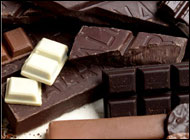Cadbury kept quiet about contaminated chocolate
Chocolate manufacturer Cadbury Schweppes has been forced to recall thousands of chocolate bars because of claims they are contaminated by salmonella.
The recall applies to seven products, 250 gram bars of Dairy Milk Turkish, Dairy Milk Caramel and Dairy Milk Mint; Dairy Milk 8 chunk bars; 1 kilogram bars of Dairy Milk: Diary Milk Button Easter Eggs (105 grams); and Cadbury Freddo bars.
The Food Standards Agency (FSA), the British government’s food watchdog, has ordered the recall and says salmonella is unacceptable at any level and Cadbury should have notified them earlier when the bacterium was found in their products.
Cadbury Schweppes apparently delayed informing health authorities for five months that minute traces of salmonella had been found at one of its UK chocolate factories.
The company remains adamant that its products are safe and is only recalling the over 1 million chocolate bars in Britain and Ireland as a preventative measure. 
Last year there were only 14 cases of salmonella montevideo, a rare strain of the disease, mostly mostly in people who had just returned from abroad.
In the four months to June, however at least 53 people are known to have become ill with severe stomach upsets after contracting salmonella montevideo.
The Health Protection Agency (HPA) has confirmed by way of molecular fingerprinting tests that the bacteria that caused the outbreaks were the same as those contaminating some of Cadbury’s products.
Salmonella montevideo can cause fever, stomach upsets and diarrhoea and the HPA suspects the real number of cases of the disease could be up to five times higher as many will have not seen a doctor.
Initially the company was insisting that low levels of salmonella in ready-to-eat foods is harmless and acceptable.
But the FSA disagrees and says any level of salmonella is unacceptable.
The contamination was apparently first found in January in chocolate at the company’s factory in Herefordshire which produces nearly 100,000 tonnes of chocolate crumb a year, which is sent to other factories to be mixed with cocoa butter and made into chocolate products.
Initially the company said the contamination was traced to a leaky pipe carrying waste water from cleaning machinery that was dripping on to the floor near a conveyor belt, a problem which was subsequently fixed.
However, according to the HPA, eight samples taken from January to June also showed contamination.
Cadbury Schweppes had sent the initial and later samples to an independent laboratory for testing and were told the samples contained salmonella.
The lab sent them on to the HPA to find out the exact strain without stating the origin of the samples.
Experts say high levels of fat and sugar in chocolate renders it an ideal vehicle for harboring salmonella and carrying it into the intestine and serious illness can be caused by just trace levels of the bacterium.
They believe food contamination outbreaks should be dealt with under the Global Food Standard rules, laid down for food manufacturers and retailers by the British Retail Consortium.
That declares that as soon as salmonella is detected a company should have deploy a crisis management procedure, including recalls of any potentially hazardous products and warning the relevant authorities.
Cadbury Schweppes has confirmed that it initiated no such procedures but instead informally decided that the salmonella levels were too low to be a threat and carried on with production.
Cadbury Schweppes only informed the FSA last week about the contamination after the watchdog began an investigation into the rise in cases of a rare strain of salmonella in Britain.
The FSA says Cadbury Schweppes should have reported the contamination sooner.
The HPA says as yet there was no evidence of any link between the cases and the Cadbury Schweppes contamination.
Cadbury’s reputation will inevitably be tarnished by the affair and the company also faces the prospect of prosecution by Herefordshire council’s environmental standards department who are angry at not being informed about the contamination when it was first detected.
The department had last inspected the factory in autumn 2005.
Revision date: July 9, 2011
Last revised: by Andrew G. Epstein, M.D.